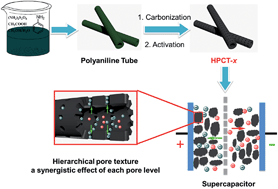Hierarchical porous and N-doped carbon nanotubes derived from polyaniline for electrode materials in supercapacitors†
Abstract
Open carbon nanotube materials with hierarchical porosity and N-doping are prepared from polyaniline nanotubes via a combination method of pre-carbonization and post-KOH activation. The morphology, pore texture and surface properties of the carbon materials are investigated by scanning electron microscopy (SEM), transmission electron microscopy (TEM), N2 adsorption, X-ray photoelectron spectroscopy (XPS), energy dispersive spectroscopy (EDS), Fourier transform infrared spectroscopy (FTIR) and Raman spectroscopy. The prepared carbon materials have a typical hierarchical pore texture and very high specific surface area up to 3253 m2 g−1. The electrochemical capacitive performance of the prepared carbons was systematically investigated in the 6 M KOH electrolyte. HPCT-4 exhibits high charge storage capacity with a specific capacitance of 365.9 F g−1 at a current density of 0.1 A g−1, good rate capability of 60% in the range of 0.1–10 A g−1, and excellent stability over 10 000 cycles. The high capacitive performance could be due to the hierarchical porosity combined with high effective surface area and heteroatom doping effects, resulting in both electrochemical double layer and Faradaic capacitance contributions.


 Please wait while we load your content...
Please wait while we load your content...